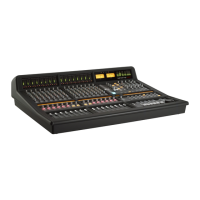Chapter 5 - DAW Control
73
Matrix
2
Owner’s Manual
Chapter 5 – DAW Control
Introduction
A wide range of DAW packages, along with associated MIDI devices such as soft synths and certain hardware instruments, can
be controlled directly from Matrix’s front panel, allowing you to run sessions with significantly less reliance on a mouse and
k
eyboard.
T
his control data is received via networked MIDI connections, using one of two standard MIDI control surface protocols: HUI
primarily used by Pro Tools, and MCU which is supported by Logic and Cubase/Nuendo amongst others. A wide range of commands are
included within these protocols, including transport control, channel and plug-in parameters, and various global commands. Other MIDI devices
can be controlled using standard Continuous Controller (CC) MIDI messages, which are generated by the Matrix channel faders, encoders and
switches when the ‘CC’ protocol is selected. Each DAW layer also supports up to 5 sets of programmable Soft Keys (see Chapter 6). These
can be programmed with either DAW specific MIDI commands or keyboard shortcuts. The combination of these two control protocols
provides a powerful and practical method to achieve tactile control of a workstation or editor.
For DAW software other than Pro Tools, Logic, and Cubase/Nuendo please refer to their operational documentation to
confirm which protocol they support.
This chapter describes how the Matrix console employs these control protocols, introducing the front panel controls
and covering any
elements of the interface which are not standard to the protocols. For descriptions of the specific functions contained within these
protocols and the standard controls associated with them, please refer to the MIDI Controller section of your DAW’s operation
manual.
This chapter presumes that the appropriate default Profiles have been assigned to the DAW layers, as described in the layer
configuration section of Chapter 1.
Layers
Matrix can connect to up to four DAW’s or software MIDI devices, one from each of four virtual ‘layers’. Each layer can be
assigned to use a particular ‘Profile’. Selecting a Profile will assign the layer to use one of the three control protocols and load a
set of Soft Key assignments, which can be customised to suit your operational needs. This is covered in more detail in Chapter 6.
Control operations performed on the Matrix control surface will then affect whichever program is assigned to the currently
selected layer.
Note that the DAWs or MIDI devices do not have to be on the same computer.
Matrix Console Layer Selection
The layers are assigned and configured in the Matrix Remote’s * tab, as
described in Chapters 1 and 6. However, selecting a layer in the Remote does not
select that layer on the Matrix console. The layer which is being controlled from
the Matrix console is selected using the *,%&' buttons, located
in the Matrix centre section, below the digital scribble strip (shown right). The selected button lights to indicate that it is active.
Layer 1 is active when none of the buttons is lit. If you wish to use Layer 1 and another layer is selected, press the lit button to
return to Layer 1.

